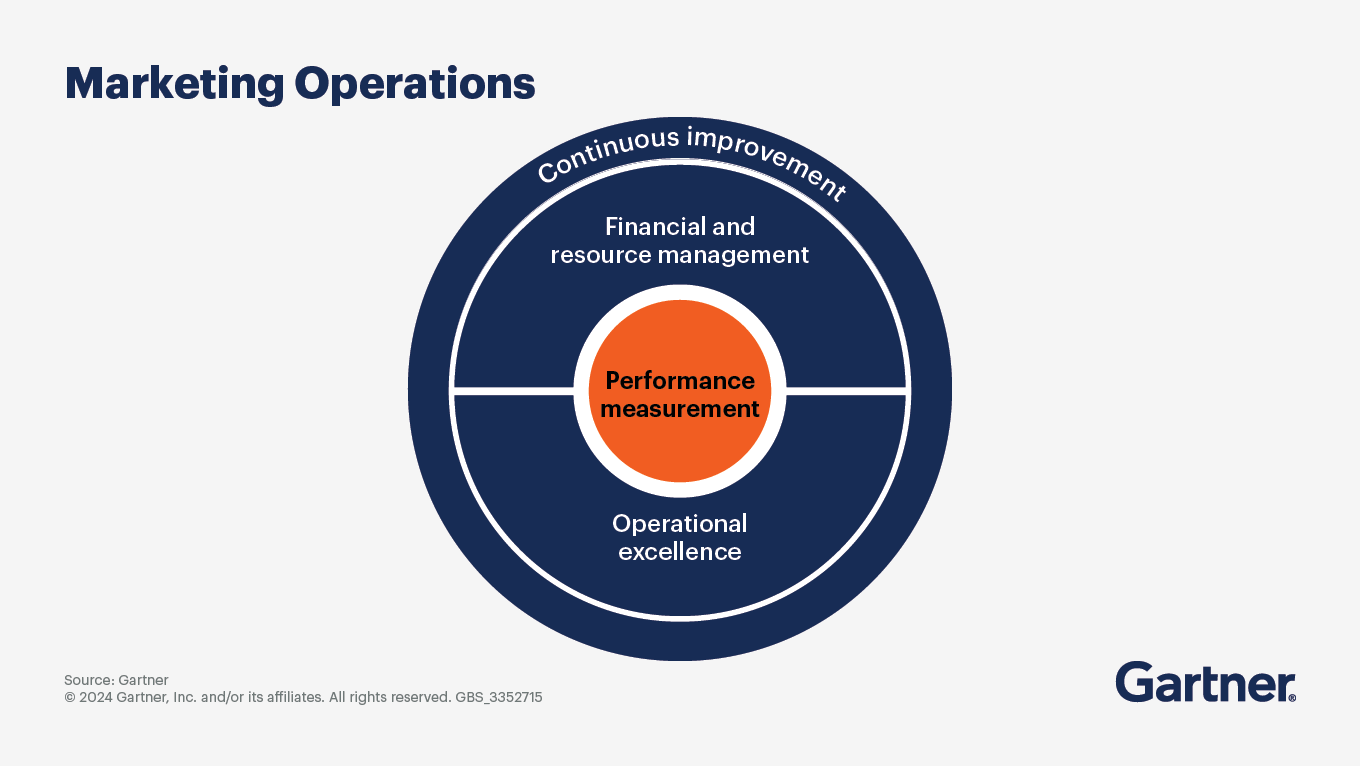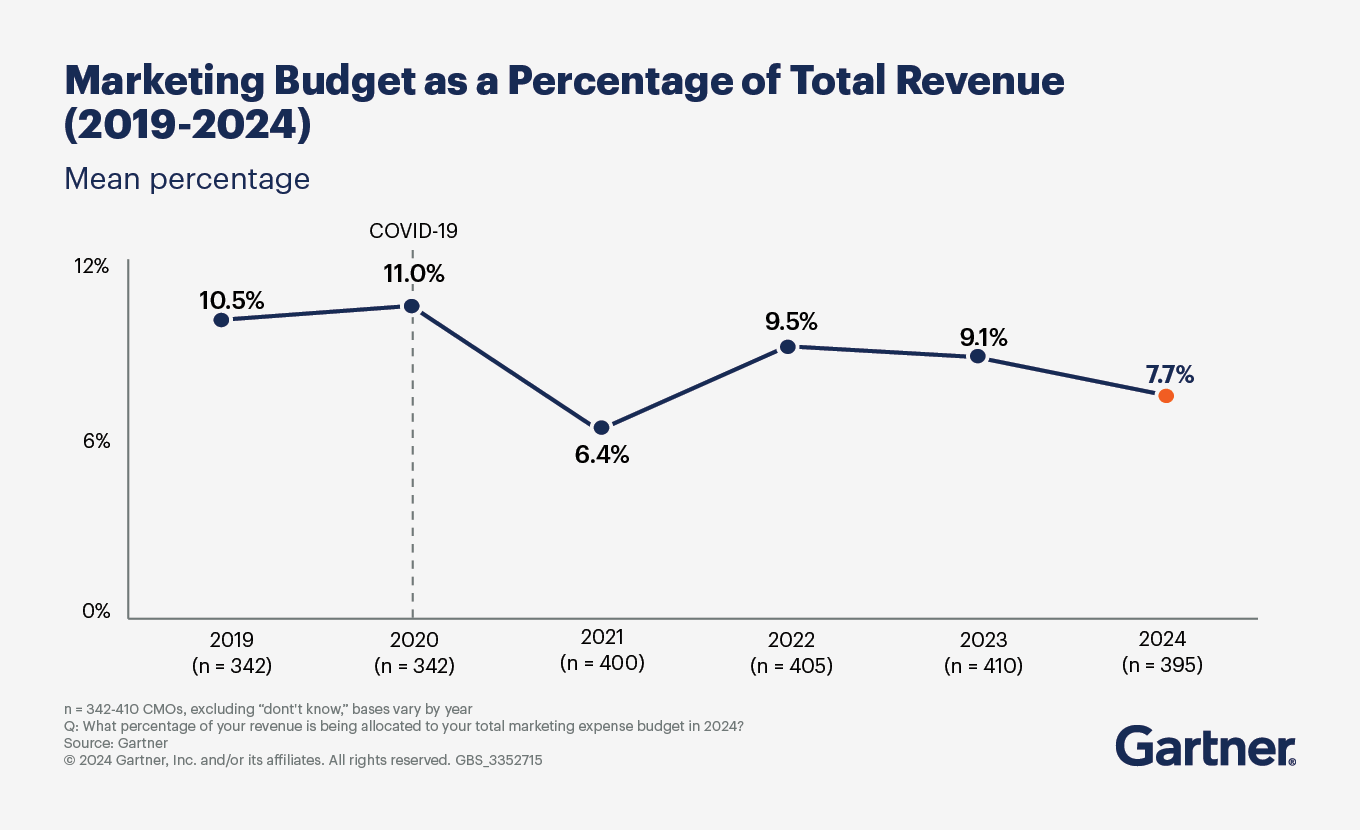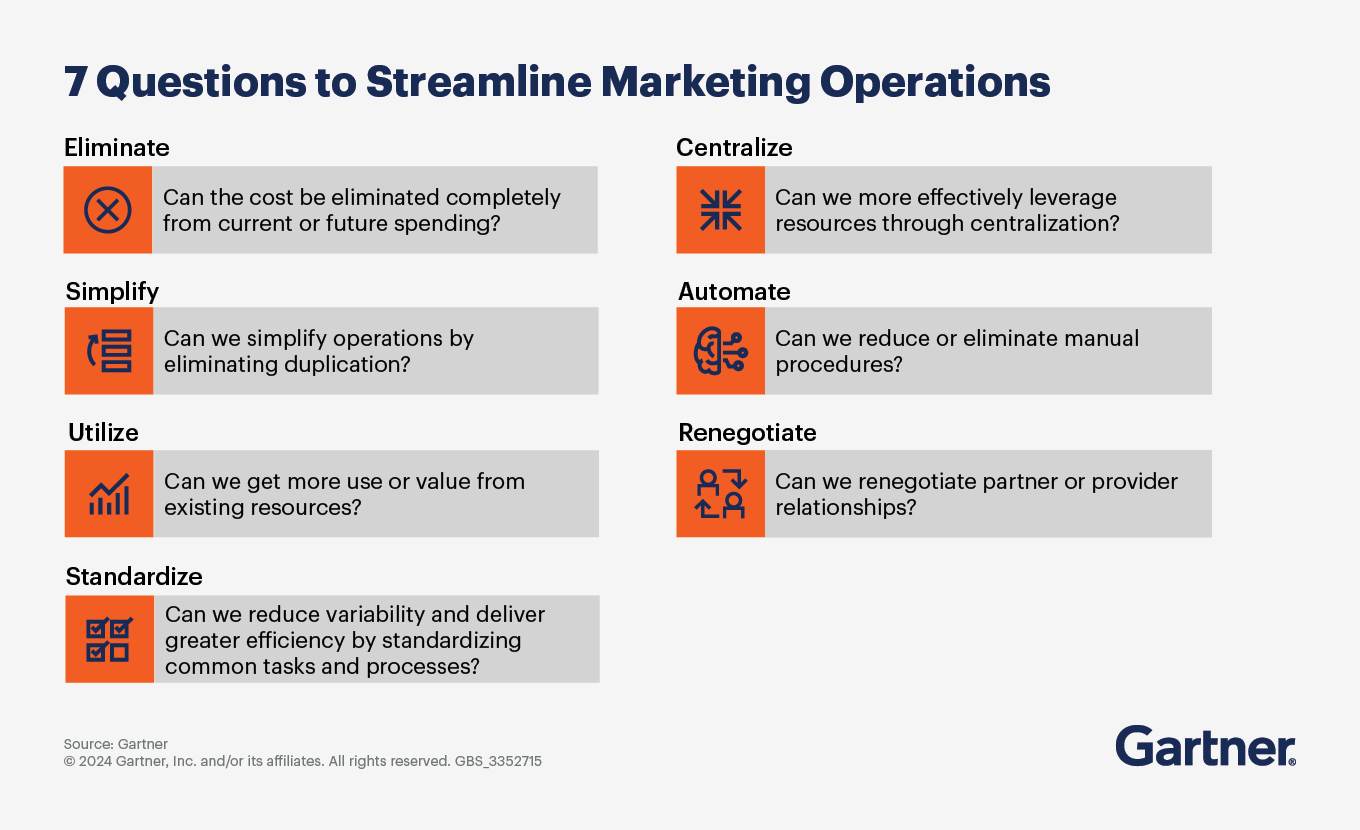Create a sustainable strategy for marketing operations success.
- Gartner client? Log in for personalized search results.
CMOs: Drive Marketing Operations Excellence in Your Organization
Budget, benchmark and build your vision for successful marketing operations
Ongoing disruption requires understanding the role of marketing operations to work in lockstep with the marketing organization to meet the growing demands of the business.
Download this CMO toolkit for actionable insights on how to:
- Benchmark your budget and strategy against peers’
- Future-proof the marketing organization to outperform competitors
- Improve martech ROI
- Cast a vision for sustainable performance and growth
Boost marketing’s impact by streamlining marketing operations
Seventy-five percent of CMOs say they face pressure to do more with less. Build a marketing operations function that supports the overall strategy by focusing on the following areas:
Value Creation
Operational Excellence
Performance Measurement
Use these steps to align marketing operations with business goals and win more funding
When a CMO can’t effectively prove the value of marketing to the business, it becomes harder to make the case for additional resources — even if marketing is productive and over capacity. With a constant flow of stakeholder requests for high-volume, low-impact work, marketing operations leaders face growing responsibility to channel critical resources toward the work that demonstrates concrete business value.
In today’s “do more with less” climate, you can hone marketing operations to pave the way for value creation by following these five steps:
Step 1: Empathize with stakeholders to better understand the cultural and situational reasons why marketing doesn’t or can’t spend more time on high-value work. Team dysfunction and complex martech solutions are two common culprits. To understand the barriers to efficient marketing operations, take these actions:
- Conduct one-to-one interviews to understand the full team dynamics.
- Document roadblocks to value creation.
- Assess use cases for generative AI in marketing operations.
- Cast a vision by openly discussing how strategic, high-value marketing operations will benefit the team.
Step 2: Evaluate the potential to increase marketing operations efficiency by considering these questions:
- If the marketing team could find the equivalent of two, five or 30 extra FTEs available each week from the existing team, how would the CMO direct that time?
- How could that work impact the business and drive growth or innovation?
- How might that work improve the customer experience?
- How many more customers could be acquired or retained?
- Could marketing start that big initiative that has been deprioritized due to lack of available resources?
Step 3: Set goals for the percentage of marketing’s time spent on high-value work. Use tiering to distinguish the work that matters most to the business from work that doesn’t equate to value creation.
Step 4: Equip marketing to shift time toward high-value work. Focus marketing operations initiatives on the following areas:
- CMO collaborations: What changes will require CMO input?
- Productivity best practices: What will force a shift from reactive to proactive marketing operations?
- Operational martech: What actions will support and transform how marketing works and gets things done?
- Marketing training: What training is needed to ease the transition of reallocating marketers’ time toward high-value work?
Step 5: Exceed your set goals for reallocation by monitoring, measuring and optimizing systems with continuous marketing operations improvements.
Look beyond cost cutting to optimize marketing operations
A typical approach to streamlining marketing operations starts with reactive, short-term fixes to cut costs. But focusing solely on cost cutting can fragment your efforts and lead to missed opportunities to drive true operational excellence.
Optimizing your talent mix can lead not only to cost savings, but greater efficiency and effectiveness. Use the following framework to evaluate your spend on marketing operations talent, both inside and outside of your organization.
- Eliminate unnecessary or mismatched functions. Capability requirements change. Review the current talent mix to make sure it meets your marketing operations goals. For example, a new hire with social media management skills could remove the need for a freelance resource — or a freelancer might make an ideal new hire in a tight talent market.
- Simplify overlapping roles and responsibilities. Evaluate the full capabilities of your teams, considering both internal and external resources. Determine how much capacity you need to deliver on your marketing operations strategy and portfolio of projects.
- Use capacity planning for resource allocation. Work management platforms can help you track marketing project cycle time, team throughput and resource utilization. Also, evaluate external agencies, contractors or vendors regularly against your marketing operations performance targets.
- Standardize to reduce variability. Which roles can you standardize to boost efficiency and accountability? Standardizing the way people set objectives, measure their performance and deliver projects — and standardizing skills through training and development — can improve overall marketing operations performance and reduce the need for specialist teams, agencies and third parties.
Centralize critical skills and capacities. Where can centralization deliver greater performance at lower costs? For example, marketing analytics are strategically important, but hard to resource. Centralizing this capability can simplify hiring and help upskill the rest of the team in an operating model like a center of excellence or a community of practice.
Automate processes and procedures. Apply people’s talents where they add the most value to the business. Use the right marketing technology to automate processes, freeing up people to provide higher-value contributions. And consider investing in martech integration upfront to help save time and money lost to manual intervention.
Renegotiate agreements with external resources. Review vendor contracts closely, from billing terms to retainers to how overages are handled. Are there any clauses protecting you from missed deadlines or deliverables? Is there overlap among vendors — e.g., are you paying both your social and your digital agencies for social listening platform licenses? After careful review of the agreements, approach your agency, vendor or freelance resources to see if they’ll agree to more favorable terms.
Choose the KPIs that matter most when measuring and advancing marketing operations
Showcase marketing’s performance by choosing key metrics for measuring marketing operations success that demonstrate marketing’s ability to execute and set a baseline for continuous improvement. Begin with the following KPIs:
- Alignment. “Did marketing’s work move the business forward?” Use stakeholder perception metrics, including overall needs met, satisfaction and timeliness.
- Timeliness. “Did marketing deliver this output on time?” Use percentage of work delivered by promised date or end-to-end cycle time as metrics.
- Capacity. “Can marketing operations effectively forecast demand and ensure there is capacity to handle it?” Rely on forecast accuracy and capacity metrics (often based on historical utilization data).
- Quality. “Did marketing deliver the work right the first time?” Use rework, number of change requests or percentage of internal (marketing) standards met as the metric.
- Progress. “Has marketing gotten better in the past month/quarter/year?” Use metrics such as percent change in goal attainment for each of the other five marketing operations goals (alignment, timeliness, capacity, quality and consistency).
- Consistency. “Can marketing repeatedly deliver high-quality work, on time, in a predictable way?” Use end-to-end process adoption.
Implement marketing operations KPIs in phases as follows:
- Begin with alignment, timeliness and capacity, which directly relate to the overarching strategy and business outcomes and are all prerequisites to quality, consistency and progress. You can measure all three regardless of the technology used to manage the work.
- After you’ve succeeded with the business outcome KPIs above, expand your focus and impact. When you’re ready for more, add a focus on quality (beyond regulatory requirements), measuring against both internal standards and stakeholder expectations.
- Consider advanced metrics once the main program is fully embedded. Progress and consistency both emphasize success at process improvement. Programs to advance these are great, but are only worthwhile once you’ve implemented and demonstrated success with the primary elements.
- Next, calculate metrics using the tools that manage the process. Marketing departments use various technologies to manage marketing activities. Sixty-nine percent of marketing operations leaders we surveyed have at least moderately broad use of software tools to manage marketing activities, but only 6% have completely adopted software tools across all of marketing.
Attend a Conference
Join Gartner experts and your peers to accelerate growth
Join CMOs and marketing executives to learn how to navigate emerging trends and challenges. From peer-led sessions to analyst one-on-ones, you'll leave ready to tackle your mission-critical priorities.
Gartner Marketing Symposium/Xpo™
Denver, CO

Marketing operations FAQs
What is marketing operations?
Marketing operations is the backbone of a marketing organization, focusing on optimizing processes, technology and data to enhance efficiency and effectiveness. It involves strategic planning, execution and analysis to ensure marketing activities align with business goals. By managing resources, streamlining workflows and leveraging analytics, marketing operations supports the delivery of high-quality campaigns that drive business growth and customer engagement.
Why is marketing operations important?
Marketing operations is crucial because it ensures that marketing strategies are executed efficiently and effectively. It aligns marketing activities with business objectives, optimizes resource allocation and enhances team productivity. By integrating technology and data analytics, marketing operations provides insights that drive informed decision making and improve campaign performance. This function helps organizations adapt to market changes, maintain competitive advantage and achieve sustainable growth.
How does effective marketing operations improve ROI?
Effective marketing operations improves ROI by optimizing resource allocation, enhancing campaign efficiency and leveraging data-driven insights. By streamlining processes and integrating technology, marketing operations reduces waste and increases productivity. Data analytics enable precise targeting and personalization, enhancing customer engagement and conversion rates. Continuous performance measurement ensures that marketing efforts align with business objectives, driving higher returns on investment.
Drive stronger performance on your mission-critical priorities.


